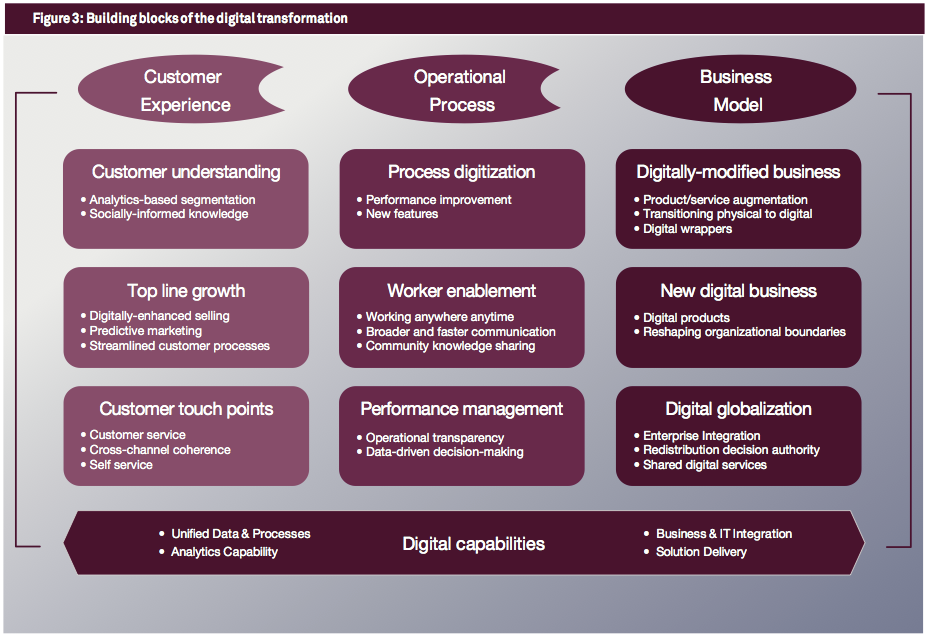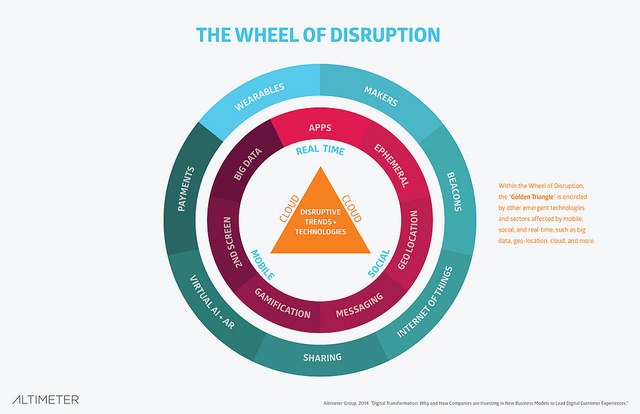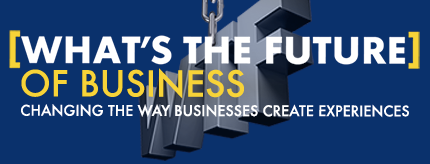Digital Darwinism is a fate that threatens most organizations in almost every industry. Because of this, businesses not only have to compete for today but also for the unforeseeable future. Digital Darwinism is the phenomenon when technology and society evolve faster than an organization can adapt. There are many reasons for this of course. Every fabric of a company is strained due to internal and external influences. The challenge lies amongst the very leaders running the show today. Their mission and the processes and systems they support today may already be working against them.
Technology and its benefits are beyond democratized among connected customers nowadays. As my friend Alex Howard points out, this is not indicative of technology around the world. There are in fact global divides on literacy, income, connectivity and wealth in the real world that we often overlook as he reminds me. And, he’s right. For clarification, I’m focusing here solely on “the connected” and the technology that is quickly becoming invisible in their lives.
Technology is now part of life among those who live an active digital lifestyle. Connected consumers or Generation-C as I refer to them represents a growing subset of consumers as a whole. They’re simply more connected than everyone else. As a result, they’re more informed and empowered. And, their expectations , at the same time, are soaring. They demand attention, personalization, and efficiency…their way. And, they require that your values match their own. This goes beyond expectations. This is about entitlement. Don’t think for a moment that this change is solely relegated to your customers or simply for b2c companies. This is about everyone, including your employees today and tomorrow.
To compete, to thrive, requires new perspective…now. It also necessitates transformation of the digital and philosophical kinds. Time is ticking. As customers and employee behavior evolve and once your competitors set out to address them, you’re reactions and actions seal your destiny and legacy.
The answer to digital Darwinism is digital transformation. Digital transformation is the use of technology and methodology to address shifts in behavior by upgrading or overhauling processes and systems that amplify existing and unforeseen opportunities.
Sounds easy right?
The real story is that many companies aren’t ready to face this challenge. Turmoil exists inside as CIOs wrestle with existing roadmaps and managing legacy departments. Managers manage against dated procedures skillsets. Marketing, sales and service teams are missing customer touch points and needs because they’re unaware of new windows or customer suppositions. At the same time, executives focus on shareholders who are also out of touch with market shifts.
Investing in technology is not the answer. That’s a reflex. Building upon the house of cards that is your existing IT infrastructure is also not the answer. Investing in digital transformation to earn newfound relevance is the goal and the solution. Now’s not the time for a wait and see mentality. If the culture of your organization is risk averse, one that waits for others to take the first step, trust me when I say that first mover advantage is indeed an advantage.
Capgemini and MITSloan set out to learn more about the challenges that face organizations, leaders and what they’re doing (or not doing) to adapt. In the seminal report released in 2012, “Digital Transformation: A Roadmap for Billion-Dollar Organizations,” the team found that all companies surveyed face common pressures from customers and employees and as such, digital transformation is now inevitable. Successful digital transformation as validated by the report does not come from implementing new technologies but instead from transforming the organization to take advantage of new possibilities that new technology provides.
Yes, it’s complicated, challenging, and terrifying. But it takes courage in the face of VUCA, volatility, uncertainty, complexity and ambiguity, to not only solve problems but admit that they exist. It also takes vision to see a new direction and leadership to unite teams and show the way. This is not something that can be defined through a bottom-up revolution. Capgemini and MITSloan found that this is in fact the duty and responsibility of executive management if change is to manifest and sustain.
The key to digital transformation according to the report, is “re-envisioning and driving change in how the company operates. That’s a management and people challenge, not just a technology one.”
Everything begins with fixing what may not appear broken today. Start by assesses the experiences your customer is having today and how their online and mobile behavior is affecting decision-making. Then, re-think and redesign your customer journey. Examine how the current infrastructure of your organization can optimize performance or where it hinders it. The answer lies in new technology, processes and business models.
The question is whether or not executives are actually in touch with the need for digital transformation and the opportunities it presents. A couple of quotes made by executives during the interview process say yes.
One executive cited younger employees as saying “Come on. I know the company’s more than 100 years old, but our IT capabilities don’t have to match the age of the company.” Another executive vocalized the reality of the massive BYOD (bring your own device) onslaught permeating businesses and firewalls everywhere. They don’t want to wait for corporate practices to catch up. One CIO shared, “Officially iPads are prohibited by our policies. Yet 50 percent of our employees are using them at work.”
So what’s the answer?
According to the report, executives are mindful when approaching digital transformation, recognizing that focusing on any one area would miss the point. Capgemini and MITSloan discovered that digital transformation is unfolding in three key areas: 1) customer experience, 2) operational processes and 3) business models.
The study also identified nine elements that defined each of the three pillars. They are as follows:
Customer Experience
- Customer understanding
- Top line growth
- Customer touch points
Operational Process
- Process digitization
- Worker Enablement
- Performance management
Business model
- Digitally-modified business
- New digital business
- Digital globalization
Successful enterprises pursuing digital transformation incorporated several elements, in their own way, as the building blocks for technology, process, and business model investments. Interesting, and not a surprise though, that no company in the sample had fully transformed or embraced all nine elements. Of course they haven’t. This is leadership not management and the vision required to move forward is as elusive as the leaders who will lead digital transformation.
To come full circle, the report also outlines the challenges facing organizations to take the first steps toward relevance.
1) Lack of impetus rises to the top. Why change when the business is performing wonderfully as is? If the company is not experiencing pain, then it’s difficult to prescribe a painkiller. As the report notes, this skepticism often results in the investment of processes that prevent digitally focused experiments and ultimately business changes.
2) Regulation and reputation rightfully plague certain businesses, especially those in financial and healthcare. There’s a piercing fear of regulatory sanction. At the same time, there are reputational considerations that may carry a far more devastating outcome should something go wrong. However, there is hope.
The study found the companies here are evaluating digital investments based on four criteria 1) Economics, 2) Burning platforms, 3) Strategic foundation investments, and 4) Low risk investments. Sometimes answers appear through every step you make, no matter how small.
3) Missing skills can prove fatal if not addressed sooner than later. Many executives use “professional judgment” to make important decisions about the future. Their competitors however are harnessing the power of big data to embrace analytic-based decision-making. Social media, mobile, big data, are just a few of many technologies disrupting businesses. I refer to this as the “Wheel of Disruption.” New skillsets are required to understand new tech, bring about change from the top-down and also to reverse mentor from the bottom-up.
4) Culture issues are often the chokehold of digital transformation. Sometimes, as the report notes, legacy leadership is part of the dead weight that prevents successful transformation and long-term viability. The best answer may in fact be to hire new leaders for their fresh perspective and the culture it can create. Successful enterprises also empower front-line workers to make autonomous decisions.
5) IT difficulties are often lacking in infrastructure and capabilities. Personally, I see this as a significant challenge and to address it requires that the IT function undergo an overhaul starting with mission and purpose. You can’t lead transformation against the current technology roadmap. With CMOs estimated to outspend their CIO counterparts, IT should replace the “I” for information with innovation. You cannot innovate, adapt, or thrive if you build on top of legacy systems that prevent true integration or at least match how employees and customers connect and communicate outside the organization.
One executive was frank on the subject, “We have through the last 50 years proliferated our IT systems and applications. We don’t retire systems. We just add on top of them, which creates a tremendous amount of expense and complexity.”
6) Decision-making is slow, sluggish and often painful. Governance issues are rooted in the inability to get find and share actionable information across the enterprise. To do so requires changes in processes and decision-making enterprise-wide. Without a top-down approach, existing governance dampens the winds of change, thus creating coordination and collaboration issues. One group may solve problems but they cannot or will not collaborate with other units. The channel conflict is real and it must be addressed through an overarching, longer-term vision.
7) Vision is commonly nearsighted. No two visions are equal as they are measured by distance and loftiness. Sometimes vision is incremental and not enough. As the study notes, “Unless senior executives establish a transformative vision of the future, managers in the rest of the firm will tend to locally optimize within their own spheres of authority.”
Challenges exist in every organization. It is how leadership addresses them now and over time that defines their fortune and legacy. This is not a time for the spaghetti theory where stakeholders randomly throw pasta on the wall to see what sticks. This is about an investment in transformation to meet or exceed customer and employee expectations at every step of their journey. It takes vision. It takes courage. It takes resilience. Without it, organizations will continue to make the same mistakes as they always have. Technology isn’t the answer; it’s an enabler.
The real value of digital transformation pays its dividends in the short-term, but its true prize is one that remains out of reach. The goal is to create a culture of empowerment, agility, innovation, and engagement. Technology is not the answer in of itself. Technology is a way of life and business. Its impact on society is only accelerating. If you do not adapt, you will fall to digital Darwinism. You are competing as much for relevance as you are market share. By re-imagining your company’s direction and how it works, technology (and people) become part of the solution instead of the problem. This increases revenue, cuts costs and improves competitive advantages.
#AdaptorDie
Connect with me…
Twitter | LinkedIn | Facebook | Google+ |Youtube | Instagram | Pinterest
Image Credit: Shutterstock
[updated to include thoughts by Alex Howard]








Company decision making is intentionally slow.
To cut out intuitive fast thinking, engaging only the “rational” brain.
It works in large ego-driven projects, in step-change, in bold moves.
But markets are fast.
Trying to outwit markets using step-change methodologies will never work.
What you must create is a system which out-evolves the market.
Which drives a tribe, rather than follows a market.
And which is continually changing, working like a servo system to keep the company on-track.
Well said Peter.
This is a really interesting article Brian, I can especially relate to your points about missing skills and I like the term ‘wheel of disruption’.
thank you.